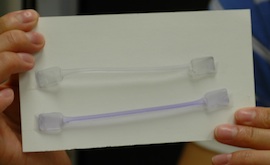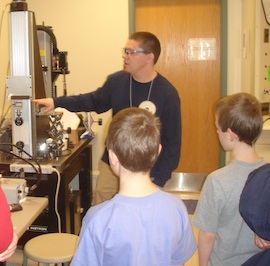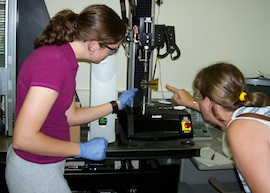Lab Tours and Demonstrations
The Moore group regularly gives lab tours in which we share our research.
We have prepared “pac men” samples to demonstrate our work on self-healing polymers. These samples (a) are made of epoxy polymer and contain microcapsules with a self-healing core liquid. The “mouth” of a pac man sample is used as a pre-crack and guides mechanical damage. Upon fracture and healing, the sample “bleeds,” showing where crack damage occurred (b). The two halves of the specimen are shown after it has been fractured into two pieces (c). On the crack faces, red healing agent is observed as it is released from ruptured microcapsules embedded in the epoxy (d).
Polymers containing covalently bound spiropyran mechanophores have also been prepared for demonstrations. As shown in the image to the right, when a polyurethane dogbone sample is stretched, it becomes purple as the colorless spiropyran reacts to form its colored merocyanine equivalent. Using irradiation with visible light, this color change can be reversed. The merocyanine reverts to its spiropyran form, and the reaction can again be induced by stretching the polymer specimen. Doug Davis shows how a load frame can be used to test the change of color in samples while measuring applied force (far right).


We have also used these demonstrations at Beckman Institute Open House and in lab tours for students from University High School (Urbana, IL). To the right, Mary Caruso demonstrates how healing efficiency is measured using a load frame. Wintergreen-filled microcapsules are shared at the open house (far right).


